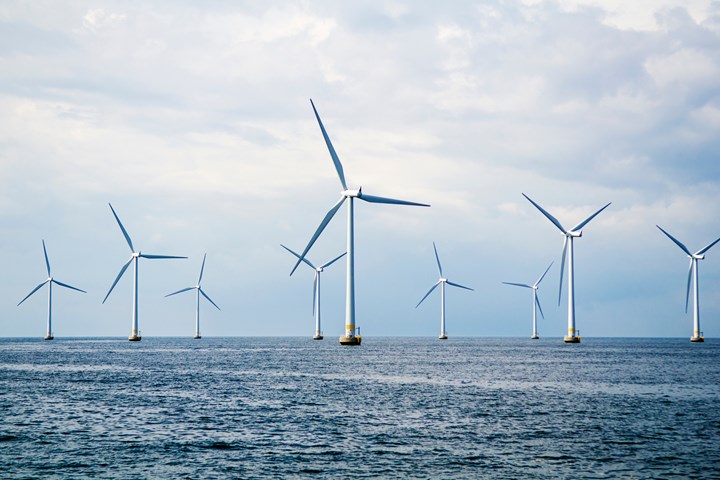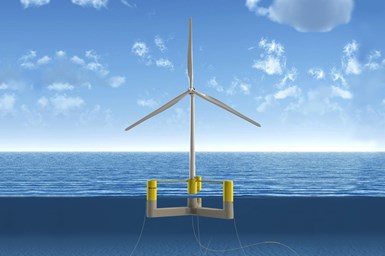Governor Mills expresses intent to expand floating offshore wind in Maine
State of Maine seeks nation’s first floating offshore wind research array, located in the Gulf of Maine, to advance new technology in collaboration with Maine’s fishing industry.

Photo Credit: Getty Images
To solidify Maine’s leadership in floating offshore wind energy and collaborate with Maine’s fisheries on the industry’s development, Governor Janet Mills announced on Nov. 20 the state’s plan to create the country’s first floating offshore wind research array in the Gulf of Maine.
With some of the highest sustained wind speeds in the world, the Outer Continental Shelf of the Gulf of Maine is said to have great potential for generating clean energy and economic opportunity for Maine, as offshore wind investment in the U.S. is estimated to top $70 billion through 2030.
Due to its deep waters, generating wind energy in the Gulf of Maine will likely come from floating offshore wind turbines, a technology still under development in the U.S which requires additional scientific study about its potential effects on fisheries and the marine environment.
Designating a small-scale research array in the Gulf of Maine represents a measured, deliberative approach that allows the state to engage the fishing industry’s expertise to minimize potential harms and maximize the benefits to Maine people from offshore wind.
“I believe Maine can lead the country in floating offshore wind technology,” says Governor Mills. “But it must be done in partnership with Maine’s fishermen, to form a science-based mutual understanding of how best to design and operate floating wind turbines in the Gulf of Maine. A research area is a prudent step toward securing our state’s leadership position, working collaboratively with fishermen and scientists, and developing offshore wind to realize the significant energy, economic and climate benefits it stands to offer.”
The research array is part of the ongoing Maine Offshore Wind Initiative announced by Governor Mills in 2019. In October, the state received a grant from the U.S. Economic Development Agency for the Initiative to support long-term planning for offshore wind with fishery, business, environmental and science representatives, as well as assessing port and infrastructure needs and evaluating the supply chain, manufacturing and workforce opportunities.
Harnessing wind resources off the coast of Maine is critical to meet the state’s climate goals of moving Maine to using 80% renewable energy by 2030, and 100% by 2050.
The state intends to file an application for the research array with the Bureau of Ocean Energy Management, which oversees renewable energy development in federal waters, which begin more than three miles off the coast.
As envisioned, the research array would be located some 20-40 miles offshore into the Gulf of Maine, in an area that would allow a connection to the mainland electric grid in the southern half of the state. The research array is expected to contain a dozen or fewer floating wind turbines over approximately 16 square miles of ocean or less. By comparison, commercial offshore wind lease areas elsewhere along the East Coast are frequently greater than 10 times this size.
Governor Mills has directed the Governor’s Energy Office (GEO) to work closely with Maine’s commercial fishing industry, the Department of Marine Resources (DMR), and other interested parties to determine the site for the research array.
“Maine’s fishing industry is a vital part of our state’s economy, heritage and identity. Its voice must be heard when considering this new offshore wind technology,” comments Patrick Keliher, Commissioner of the Department of Marine Resources. “The Department welcomes the chance to work proactively with the fishing industry to hear and understand its concerns about offshore wind, and to ensure its perspectives inform the development and operation of the research array in the Gulf of Maine.”

The state’s partners in the research include the University of Maine, whose floating foundations (see “UMaine develops collaborative floating offshore wind demo project”) will be utilized in the array, and New England Aqua Ventus — a joint venture of Diamond Offshore Wind (DOW), a subsidiary of Mitsubishi Corp. (Tokyo, Japan), and RWE Renewables (Essen, Germany), one of the world’s largest offshore wind energy companies — which will lead the array’s development.
It is emphasized that harnessing the unequaled wind resources off the coast of Maine is critical to meet the state’s climate goals of moving Maine to using 80% renewable energy by 2030, and 100% by 2050, in order to curb harmful greenhouse gas emissions. This effort is of importance in the Gulf of Maine, where surface temperatures are said to have peaked this past summer and have been warming faster than nearly every other body of water in the world.
“Maine is seeing the impact of climate change directly on our weather and our waters, and we should grasp the opportunity to help lead the national and global response to this existential threat,” says Senator Angus King, a founding member of the bipartisan Climate Solutions Caucus in the U.S. Senate, and member of the Senate Energy and Natural Resources Committee. “By bringing together all those who work and rely upon our natural resources, this is a unique opportunity to strike the best balance, harmonize our methods and create a united front against one of the defining challenges of our time.”
The development of offshore wind represents a significant opportunity for Maine’s energy future and economic recovery from COVID-19, as outlined in from the Governor’s Energy Office. Both encourage the state to set forth a balanced agenda that maximizes economic benefits for Maine people while creating a culture of innovation that creates a foundation for future leadership in this growing industry.
Through the Maine Offshore Wind Initiative as well, Governor Mills in March and called for a study to analyze this opportunity. That study is expected later this year.
Maine is also continuing to work with New Hampshire and Massachusetts on BOEM’s Gulf of Maine Task Force to evaluate commercial scale renewable energy leasing and development on the Outer Continental Shelf.
Related Content
Infinite Composites: Type V tanks for space, hydrogen, automotive and more
After a decade of proving its linerless, weight-saving composite tanks with NASA and more than 30 aerospace companies, this CryoSphere pioneer is scaling for growth in commercial space and sustainable transportation on Earth.
Read MoreZEBRA project demonstrates closed-loop wind recycling system
Consortium partners have proven the complete recycling of thermoplastic wind turbines via two manufactured wind blades, featuring reduced operating cost, CO2 emissions.
Read MoreComposites end markets: Energy (2024)
Composites are used widely in oil/gas, wind and other renewable energy applications. Despite market challenges, growth potential and innovation for composites continue.
Read MorePolar Technology develops innovative solutions for hydrogen storage
Conformable “Hydrogen in a Box” prototype for compressed gas storage has been tested to 350 and 700 bar, liquid hydrogen storage is being evaluated.
Read MoreRead Next
Cutting 100 pounds, certification time for the X-59 nose cone
Swift Engineering used HyperX software to remove 100 pounds from 38-foot graphite/epoxy cored nose cone for X-59 supersonic aircraft.
Read MoreUltrasonic welding for in-space manufacturing of CFRTP
Agile Ultrasonics and NASA trial robotic-compatible carbon fiber-reinforced thermoplastic ultrasonic welding technology for space structures.
Read MoreNext-gen fan blades: Hybrid twin RTM, printed sensors, laser shock disassembly
MORPHO project demonstrates blade with 20% faster RTM cure cycle, uses AI-based monitoring for improved maintenance/life cycle management and proves laser shock disassembly for recycling.
Read More












